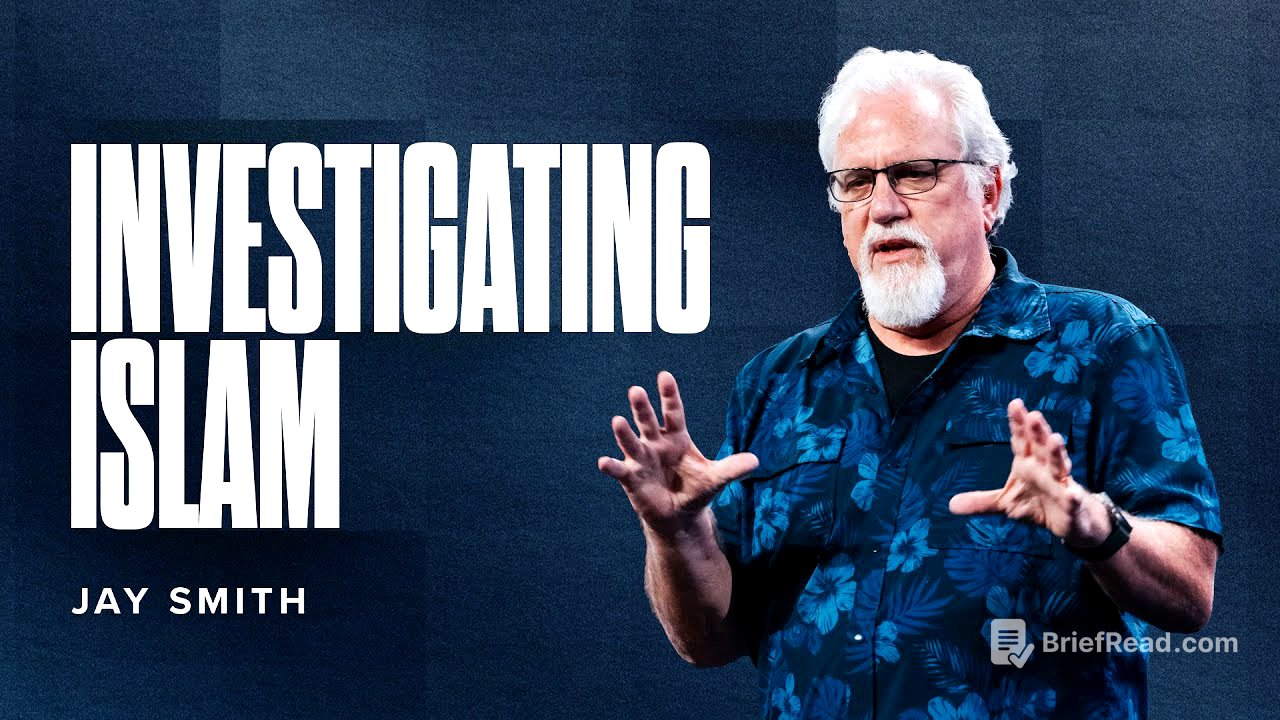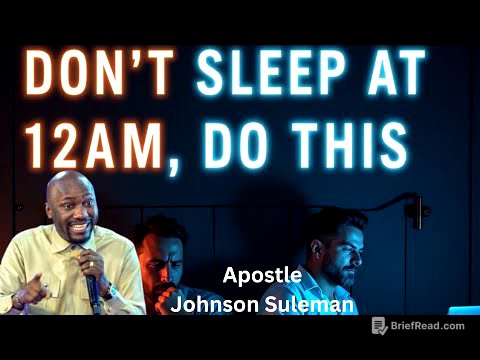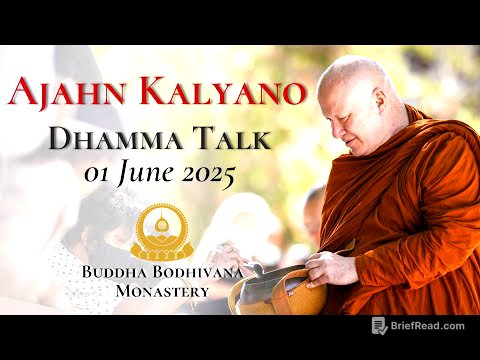TLDR;
This video presents a historical critique of Islam, challenging the standard Islamic narrative (SIN) concerning the origins and authenticity of Islam's key elements: Mecca, Muhammad, and the Quran. Using primarily 7th-century evidence, the speaker aims to dismantle the traditional Islamic claims.
- The speaker questions the reliability of Islamic sources, noting they were written 200-300 years after the events they describe and far from Mecca and Medina.
- The speaker challenges the historical existence and importance of Mecca, arguing that it is absent from 7th-century maps and trade routes.
- The speaker analyses the figure of Muhammad, pointing out the lack of contemporary references and the Christian context of early coins and inscriptions.
- The speaker examines the Quran, highlighting the late development of its script, the existence of numerous variant versions, and its reliance on pre-existing Christian texts.
Introduction [0:00]
The speaker introduces a unique presentation aimed at dismantling the foundations of Islam—Muhammad, the Quran, and Mecca—using only 7th-century evidence. He highlights the importance of examining the standard Islamic narrative (SIN), which influences all aspects of Muslim life. The speaker introduces books that confront the Quran and shut down the manuscripts of the Quran. He outlines the four key areas of focus: the problem with Islamic sources, Mecca, Muhammad, and the Quran.
The Standard Islamic Narrative (SIN) [2:26]
The speaker outlines the core claims of the standard Islamic narrative (SIN): Muhammad, born in Mecca around 570 AD, is the last and greatest prophet who received the Quran between 610 and 632 AD. The Quran is considered the perfectly preserved final revelation, and Islam is the ultimate religion based on Muhammad's life (Sunnah) and the Quran's teachings. The speaker emphasises that these claims depend on the authenticity of the book (Quran), the man (Muhammad), and the place (Mecca), all of which will be scrutinised using 7th-century evidence from the central part of Arabia, the Hijaz, where Mecca and Medina are located.
The Problem with Islamic Sources [3:55]
The speaker addresses the problem of the sources for the standard Islamic narrative. He points out that the traditional accounts of Muhammad's life, the Hadith (sayings and actions of Muhammad), Quranic commentaries (Tafsir), and historical accounts (Tariq) were not written down until 200 to 300 years after Muhammad's death. The first biography (Sira) was written by Ibn Ishaq, who died in 765 AD, over 130 years after Muhammad. The Hadith collections were compiled even later, in the 9th and 10th centuries. The speaker notes that the writers of these traditions lived and worked far from Mecca and Medina, primarily in Baghdad and other northern cities. He contrasts this with Christianity, where the Gospels and other New Testament writings were written within 30 to 60 years of Jesus's death by people who knew him or had access to eyewitness accounts.
The Biography of Muhammad [14:26]
The speaker challenges the accepted biography of Muhammad, noting that the standard work on Muhammad's life is based on the research of Heinrich Ferdinand Wüstenfeld, a 19th-century German scholar. Wüstenfeld compiled available information on Muhammad from various sources and published it in 1860. This compilation was then translated and popularised by Alfred Guillaume. The speaker emphasises that the biography of Muhammad relied upon by Muslims today originates from a German scholar who lived over 1,000 years after the supposed events. He highlights the dilemma this poses for scholars and suggests returning to 7th-century evidence to assess the historical accuracy of the Islamic narrative.
Challenging Mecca's Historical Significance [17:03]
The speaker explains the importance of Mecca to Islam, stating that if Mecca can be discredited, the entire religion collapses. He notes that according to Islamic tradition, Mecca is the oldest city in history, where Adam and Eve were cast down, and where Abraham lived. It is also described as a major centre of trade. However, the speaker points out that the name "Mecca" appears only once in the Quran. The speaker highlights discrepancies between the Quranic and traditional descriptions of Mecca. The traditions describe Mecca as being in a valley with streams, fields, trees, and fruit, while the actual Mecca is a barren desert with no water.
Geographical Discrepancies in the Quran [20:03]
The speaker analyses the geographical references in the Quran, noting that it frequently mentions people from various locations such as "people from Midian" and "people from 'Ad". These places are located in Jordan, hundreds of miles north of Mecca. The speaker questions how Muhammad could have had daily contact with these people if he lived in Mecca, given the distance and lack of transportation. He also points out the Islamic tradition that numerous prophets are buried in Mecca, yet archaeological excavations during construction have not uncovered any evidence of these burials.
Absence of Mecca in Historical Records [21:55]
The speaker notes that the first reference to Mecca appears in 741 AD, over a century after Muhammad's death. He shows maps from Ptolemy and later cartographers that do not include Mecca. He references Dan Gibson's research on the qiblas (direction of prayer) of early mosques, which shows that until 706 AD, all qiblas faced Petra, not Mecca. It wasn't until 715 AD that the first mosque facing Mecca appeared, suggesting that for over a century, Muslims did not know where Mecca was or that it was the direction of prayer.
Debunking the Trade Route Theory [23:57]
The speaker addresses the theory that Mecca's importance stemmed from its location on a major trade route. He references Patricia Crone, who refuted this theory. Crone argued that if trade goods were unloaded in Aden, caravans would follow the Western Plateau, bypassing Mecca, which lies 3,000 feet below the plateau. She also questioned why traders would choose a 1,250-mile land route when they could use the Red Sea. Crone's research into trade documents from the 2nd to 7th centuries revealed that ships sailed up the Red Sea to ports on the African side, which had fresh water and larger populations, rather than the Arabian side.
The Red Sea Trade Route and the Non-Existence of Jeddah [27:49]
The speaker explains that ships used channels on the African side of the Red Sea due to the availability of ports and fresh water. He notes that the only known port on the Arabian side was Yanbu, which supported Yathrib (Medina). He addresses the question of Jeddah, the port that supposedly supported Mecca. Citing Dr. John Hultin, the speaker states that Jeddah did not exist until the 8th century AD and was created to provide provisions for Mecca, which lacked water.
Lack of Historical Awareness of Mecca [29:42]
The speaker references Patricia Crone's research into historical empires and civilisations, noting that none of them—Assyrians, Babylonians, Romans, Persians, Nabataeans, or others—had heard of Mecca until the 8th century. He contrasts this with other towns in the region, such as Najran and Sanaa, which were well-known and documented by Greek and Roman writers. The speaker concludes that Mecca's absence from historical records is due to its location in a desert with no water, food, or people, thus no civilisation or history.
The Hajj and its Plagiarised Elements [32:29]
The speaker examines the Hajj pilgrimage, noting that many of its elements are plagiarised from Judaism and Christianity. The circumambulation of the Kaaba seven times counterclockwise is derived from Jewish practices in Jerusalem. The running back and forth between Safa and Marwa is a re-enactment of Hagar's search for water, but the speaker points out that the actual locations of Safa and Marwa are small rocks near the Kaaba, not mountains in the desert. The original Safa and Marwa are Mount Moriah and Mount Scopus in Jerusalem. The speaker also notes that the throwing of stones at the Jamarat is derived from Jewish traditions.
The Black Stone and Mecca's Demise [35:32]
The speaker questions the significance of the Black Stone in the Kaaba, which Muslims kiss to have their sins forgiven, calling it idolatry. He summarises the evidence against Mecca's historical importance, noting that it is absent from the Quran, debunked by trade route theories, contradicted by qibla directions, and unsupported by historical maps. He concludes that Mecca did not exist until 741 AD and that its rituals and structures were derived from Petra and Jerusalem.
Questioning the Existence of Muhammad [36:47]
The speaker transitions to the topic of Muhammad, questioning his historical existence and role in Islam. He notes that everything known about Muhammad comes from sources written centuries after his supposed lifetime. He examines coins from the 7th century, noting that early coins from the region are Christian, with crosses and no Islamic symbols. The first reference to "Muhammad" appears on coins from Muawiya, but the speaker suggests that "Muhammad" (the praised one) refers to Jesus Christ, as Muawiya was a Christian.
Abdul Malik and the Dome of the Rock [40:05]
The speaker discusses Abdul Malik, who introduced new coins with the Shahada (Islamic declaration of faith). However, Abdul Malik also built the Dome of the Rock, which contains inscriptions attacking the divinity of Jesus Christ. The speaker argues that Abdul Malik was an anti-Trinitarian Christian who used the title "Muhammad" to refer to Jesus and that the early Islamic movement was a form of Christianity aimed at confronting Byzantine Christianity.
Inscriptions and References to Muhammad [41:48]
The speaker notes that inscriptions from the period are found in the north but not in Mecca, due to the lack of water. He references Ilkalinstad's research, which shows that early Arabic inscriptions contain pious formulas related to Christianity, and it is not until 690-710 AD that the prophet Muhammad is introduced. The speaker examines external references to Muhammad in the 7th century, noting that they place him in locations far north of Mecca, such as Iraq, Damascus, and Jerusalem. These references likely refer to a different "Muhammad" or "praised one".
The Quran: Uncreated, Sent Down, Complete, and Unchanged? [45:09]
The speaker moves on to the Quran, outlining the Muslim claims that it is uncreated, sent down to Muhammad, completed by Uthman in 652 AD, and unchanged in the last 1400 years. He contrasts this with the Christian view of the Bible, which is created, inspired, and has known textual variations. The speaker focuses on challenging the claims that the Quran is complete and unchanged.
Contradictions in the Quranic Narrative [47:18]
The speaker references Sahih Bukhari, who states that the Quran was written down in its final form during the time of Uthman and that copies were sent to five cities. However, other early Qurans existed with different numbers of surahs (chapters) and significant textual variations. Arthur Jeffery's research indicates that there are about 15,000 differences between these early manuscripts and the Quran today. The speaker questions why, unlike the Bible, no original Quran manuscripts from the 7th century exist.
The Development of the Arabic Script [49:10]
The speaker discusses the development of the Arabic script, noting that early manuscripts lacked dots and vowels, making them difficult to read. Dots were added in the 8th century, and vowels were added in the late 8th and early 9th centuries. This means that the Quran was initially written in an ambiguous script, leading to different interpretations and readings.
The Proliferation of Quranic Versions [50:39]
The speaker explains that the lack of dots and vowels led to the creation of numerous different versions of the Quran. By the 10th century, there were 700 different Qurans. In the 10th century, Ibn Mujahid was tasked with choosing seven canonical readings. The speaker lists the seven chosen readers, noting that they all lived in the 8th and 9th centuries, long after Muhammad.
The 30 Different Qurans and 93,000 Differences [53:02]
The speaker explains that over time, the number of recognised Quranic readings expanded to 30, with significant differences between them. The speaker reveals that there are 93,000 differences between the Hafs Quran, which is the most widely used version today, and the other 29 versions. This information was discovered by Hatun Tash, who found multiple Quranic versions in bookstores in Morocco, Yemen, and Jordan.
The Admission of Quranic Variation [55:53]
The speaker recounts an incident where Muhammad Hijab, a popular Muslim figure, was confronted with the evidence of Quranic variations. Hijab consulted with Yasir Qadhi, a leading Islamic scholar, who admitted that the issue of Quranic variation is a difficult problem for Muslim scholars. Qadhi acknowledged that Western scholars have made significant advances in understanding the issue and that the standard Islamic narrative has holes in it. He ultimately admitted that all 30 Quranic versions are considered the Quran, implying that the Quran is a composite text.
Manuscript Evidence and Textual Changes [59:14]
The speaker contrasts the abundance of early New Testament manuscripts with the scarcity of early Quranic manuscripts. He notes that the few existing Quranic manuscripts are from the 8th, 9th, and 10th centuries and contain significant variations. He references Dan Brubaker's research, which has identified insertions, erasures, and overwriting in Quranic manuscripts, all aimed at standardising the text to match the Hafs version.
The 1924 Cairo Edition and its Aftermath [1:01:30]
The speaker explains that the Quran used today is based on the 1924 Cairo edition, which was chosen by one scholar due to disagreements among students. The other 29 versions were discarded into the Nile River. This edition was adopted by Egypt in 1936 and by Saudi Arabia for worldwide distribution in 1985. The speaker points out that many people alive today are older than the version of the Quran currently in use.
The Quran's Christian Origins [1:05:12]
The speaker introduces Gunther Luling, who discovered that portions of the Quran were originally Christian hymns. By removing Arabic dots and vowels and replacing them with Syriac, Luling found that beautiful poetry in the Quran was Christian in origin. The speaker also references Christoph Luxenberg, who found that 25% of the Quran's dark passages, which are incomprehensible to scholars, could be understood by tracing them back to Aramaic roots. These passages turned out to be Christian lectionaries, homilies, and hymns about Jesus Christ.
Conclusion: Jesus Christ as the True Revelation [1:09:05]
The speaker concludes by reiterating the four criteria Muslims demand of the Quran: it must be eternal, sent down, complete, and unchanged. He argues that these criteria are not met by the Quran but are perfectly fulfilled by Jesus Christ, who is the eternal Word of God. The speaker urges Christians to bring Muslims to a better and greater revelation in Jesus Christ.









